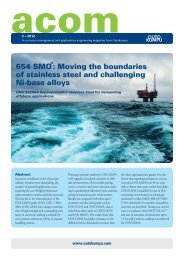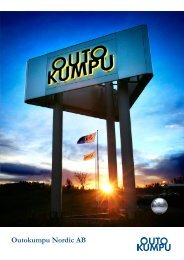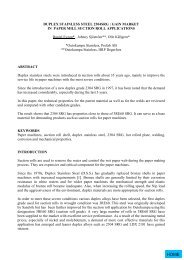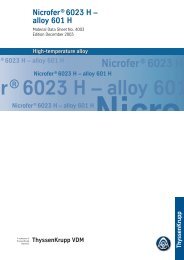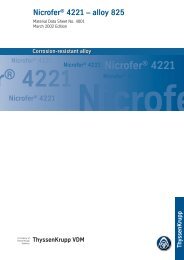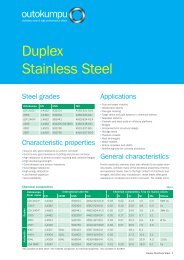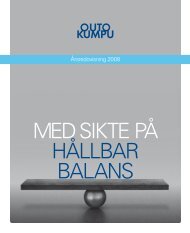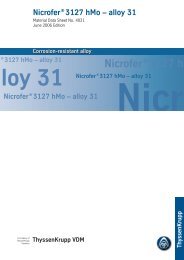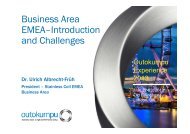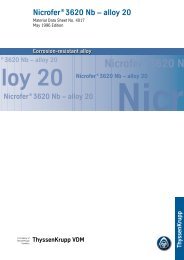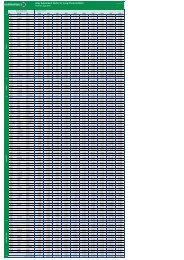Annual Report 2010 - Outokumpu
Annual Report 2010 - Outokumpu
Annual Report 2010 - Outokumpu
Create successful ePaper yourself
Turn your PDF publications into a flip-book with our unique Google optimized e-Paper software.
136<br />
<strong>Outokumpu</strong> also complies with regulations regarding financial reporting published by the Financial Supervisory Authority<br />
(FIN-FSA) and NASDAQ OMX Helsinki.<br />
Risk identification and assessment<br />
Risk management processes connected with the Group's financial reporting are coordinated by the Treasury and Risk<br />
Management function. Related risks are classified as operational risks and can arise as a consequence of inadequate or<br />
failed internal processes, employee actions, systems or other events such as misconduct or crime. The aim of the<br />
<strong>Outokumpu</strong> risk management process is to identify, evaluate, control and mitigate such risks. Major risks are reported to<br />
and evaluated by the Audit Committee on a regular basis. <strong>Outokumpu</strong>'s risk management process includes arranging<br />
workshops on the identification of key risks, including operational risks, for business units and other Group functions.<br />
Deliverables include risk maps and risk identification plans. In <strong>2010</strong>, a risk workshop regarding financial reporting was<br />
held. The outcome of the workshop will be started to be implemented in financial reporting processes during 2011.<br />
Internal audit<br />
<strong>Outokumpu</strong>'s Internal Audit function has an independent role and a twofold objective: to provide assurance and to offer<br />
consulting services which add value and improve the organisation's operations. Internal Audit's most important task is<br />
assisting the Audit Committee and the Executive Committee in fulfilling their control functions. To do this, Internal Audit<br />
identifies and monitors significant operational risks within the Group, ascertains the adequacy and effective operation of<br />
internal controls and provides the two committees with a direct source of correct and reliable information. Other tasks<br />
carried out by Internal Audit include monitoring the Group's principles, controls and policies and follow-up of the audit<br />
conclusions by the company's external auditors. The internal auditor reports to the Audit Committee and administratively<br />
to the CFO.<br />
Control activities<br />
In addition to the Board of Directors and Audit Committee, operational management teams in <strong>Outokumpu</strong> are<br />
responsible for ensuring that internal controls relating to financial reporting are in place at all <strong>Outokumpu</strong> units. The aim<br />
of control activities is to discover, prevent and correct potential errors and deviations in financial reporting. Control<br />
activities aim also to ensure that authorisation structures are designed and implemented in a way that conflicting division<br />
of work will not exist (one person performing an activity and also being responsible for controlling that activity). Control<br />
activities consist of different kind of measures and include reviews of financial reports by Group management and in<br />
business unit management teams, the reconciliation of accounts, analyses of the logic behind reported figures, forecasts<br />
compared to actual reported figures and analyses on the Group's financial reporting processes, to mention a few. A key<br />
component is the monitoring of monthly performance against financial and operational targets. These control activities<br />
take place at different levels in the organisation. The most important accounting items in <strong>Outokumpu</strong> are the valuation<br />
and reporting of inventories and other working capital items. These items are carefully monitored and controlled both in<br />
the units and at the Group level.<br />
Information technology and solutions play an important role in guaranteeing that the Group's internal controls have a<br />
solid foundation. The harmonisation of IT systems to further improve <strong>Outokumpu</strong>'s internal control environment is ongoing.<br />
During the financial year, e-invoicing was implemented in some <strong>Outokumpu</strong> units and the plan is to expand its use<br />
within the Group in 2011. In <strong>2010</strong>, a unified accounting system for OSTP Units (TSAP) was finalised and implemented.<br />
Also the planning for SAP travel management system in Sweden was started.<br />
Information and communication<br />
Group-wide policies and principles are freely available to all <strong>Outokumpu</strong> employees. Instructions relating to financial<br />
reporting are communicated to all the parties involved. The main communication channels employed are <strong>Outokumpu</strong>'s<br />
intranet and other easily-accessible databases. Face-to-face controller meetings are also organised. In <strong>2010</strong>, Senior<br />
<strong>Outokumpu</strong> <strong>Annual</strong> <strong>Report</strong> <strong>2010</strong> – Corporate Governance – Financial <strong>Report</strong>ing




